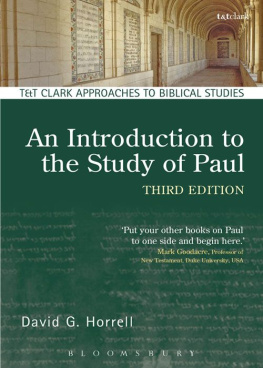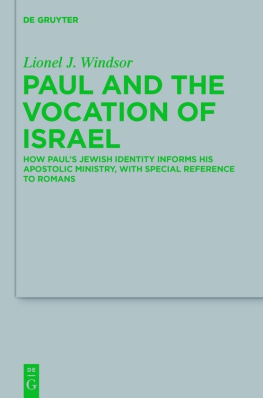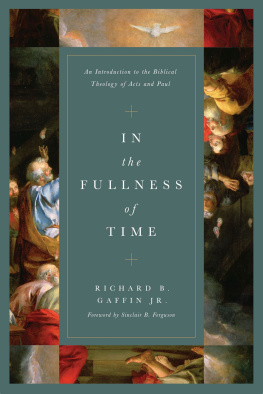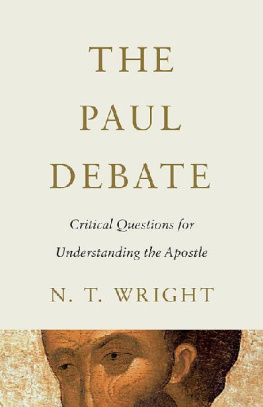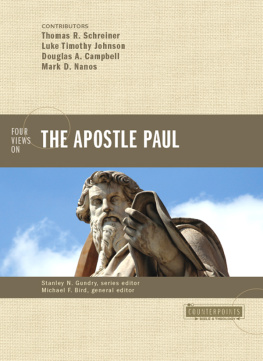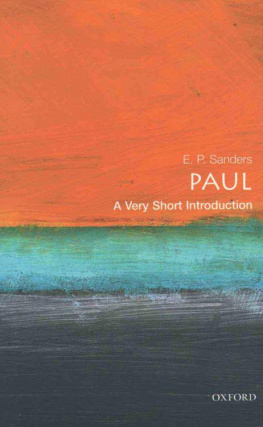Other titles in the T&T Clark Approaches to Biblical Studies series include:
An Introduction to Revelation , Gilbert Desrosiers
The Pentateuch: A Story of Beginnings , Paula Gooder
An Introduction to the Psalms , Alistair G. Hunter
An Introduction to the Study of Ezekiel , Michael A. Lyons
Jesus and the Gospels (Second Edition), Clive Marsh and Steve Moyise
Joshua to Kings , Mary E. Mills
Introduction to Biblical Studies (Third Edition), Steve Moyise
The Old Testament in the New , Steve Moyise
An Introduction to the Study of Luke-Acts , V. George Shillington
An Introduction to the Study of Isaiah , Jacob Stromberg
An Introduction to the Study of Wisdom Literature , Stuart Weeks

Contents
| BCE | Before the Common Era |
| CE | the Common Era |
| cf. | confer (Latin), meaning compare |
| DGH | my initials: denotes my own translation |
| KJV | King James Version |
| LXX | Septuagint (the Greek translation of the Hebrew scriptures) |
| NIV | New International Version |
| NRSV | New Revised Standard Version |
| P. Oxy. | the Oxyrynchus Papyri |
| RSV | Revised Standard Version |
In a kind review of the second edition of this book, which was published six years after the first edition, Peter Oakes commented that six years seemed about the right time-gap between editions. I have let a few more years slip past this time, but am grateful for the encouragement from Dominic Mattos, at Bloomsbury T&T Clark, to produce a third edition. I am naturally pleased that the book seems to be appreciated as a way in for those beginning their studies of Paul and I remain convinced that the books value lies primarily in its attempt to introduce students to the diversity of scholarly perspectives on Paul and to alert them to the evidence and issues that underpin this diversity. Authors who focus on giving their own view of Paul often do not alert readers to the alternative ways of understanding the same evidence. I hope I give my readers a reasonable introduction to Paul and his writings, but my particular aim is to orientate them to the scholarly discussion of the Pauline literature, and thus to equip them to begin their studies with some critical awareness of the differing perspectives they will encounter. It is fundamentally, as the title conveys, an introduction to the study of Paul.
In revising the book, I have sought to update the discussion and to add some of the important recent literature, not least in the suggestions for further reading at the end of each chapter. These suggested readings are not included in the final bibliography, which compiles only those items cited in my own footnotes. There have been many small alterations throughout, but the most significant additions are in Chapters 57. Chapter 7 has been somewhat restructured as well as updated partly because, as Peter Oakes helpfully reminded me, it is hardly appropriate any longer to refer to social-scientific and feminist perspectives as new. Nonetheless, the book is not radically different from the previous editions, and I have deliberately limited the amount of discussion of recent literature. Unlike some disciplines, especially in the sciences, where new knowledge can rapidly render older literature entirely out of date, the field of New Testament studies is one in which the scholarship of former decades continues to establish the key contours for much ongoing debate. It is, I think, more helpful for students beginning their studies to encounter the main influential perspectives than to be overwhelmed with the full range of current debate. Once they have begun to see how and why the different perspectives emerge, they should be better placed to begin to engage critically with the more recent discussion.
As in earlier editions, the footnotes and suggestions for further reading contain only works available in English (though many of these are translations, most often from German). This seems to me appropriate in a book published in English for undergraduates, ordinands and others beginning their studies of Paul. As Stephen Westerholm commented in a generous review of the second edition, however, it would be unfortunate and misleading to give the impression that the important and relevant research on Paul is all published (or made available) in English. Let me stress, therefore, that scholarly studies of Paul are published in many languages, are not always translated, and that German scholarship in particular is highly important and influential in the field as those who progress to more advanced levels of study will quickly discover. Westerholm also comments in that review, with typical dry wit, that students may come away from this book with the impression that scholars disagree about almost everything. While this impression (as Westerholm indicates) is not exactly false, I also hope readers will be able to see that there is a reasonable amount of agreement and clarity, at least at the level of broad-brush outlines.
Finally, some words of thanks: I would like to express my continuing gratitude to the successive generations of students at Exeter who have taken my course Introducing Paul. The course is compulsory, so they have no choice about taking it, which makes me appreciate all the more their interest and enthusiasm. I am very grateful to Peter Oakes and Mark Reasoner for suggestions as to how this new edition might best be updated, though they bear no responsibility for what I have actually done. I am grateful to David M. Shaw for producing from my various files a single document of the second edition, ready for editing, and for compiling the indexes. I am also grateful to my father-in-law, Mike Round, for pointing out that the phrase he has taught Paul for the last nine years used on the back of the first edition sounded rather odd, if not presumptuous, hence the change in the second edition to Pauline studies! Most of all, however, I reiterate my profound sense of gratitude to Caroline, Emily and Cate; one of the privileges of producing subsequent editions of this book is the opportunity to repeat my appreciation for them and all the happiness they bring me.
I am naturally pleased that this volume, and the series of which it is a part, has proven useful enough to warrant a second edition. In the time since this book was first published further introductory works on Paul have of course appeared. Some, like Morna Hookers, are brief studies comparable in length to this one; others, like Michael Gormans, are big books, covering all of the letters in some detail. Nonetheless, as far as I am aware, it is still the case that these works, hugely valuable though they are, present a view, an interpretation, of Paul and his letters. They do not take as their main aim what I seek to do here: to introduce students to the range of approaches, perspectives, issues and debates in the scholarly study of Paul. Rather than get one portrait of Paul, students who study this book will get some insight into the different views that various scholars argue for and the evidence on which these views depend, and will thus, I hope, be equipped to begin their own critical evaluation of the material they encounter in the world of contemporary Pauline studies.
It will no doubt be useful for readers to know how this edition differs from the first. In revising the material, I have updated the bibliographical references and suggestions for further reading; amended phrases and added sentences here and there; added, at the series editors suggestion, three questions for further study at the end of each chapter; and, most importantly, added or expanded a number of sections, generally to bring the discussion up to date. The questions for further study may be used as points around which to focus class or group discussion, areas for wider reading and research, or perhaps the basis for essay assignments. The most significant additions or expansions are as follows: in Chapter 1, a section on the world(s) in which Paul lived (pp. 67); in Chapter 5, some additional material on the narrative basis of Pauls theology and his use of scripture (pp. 8083), on the pistis Christou debate (pp. 10710) and on Pauls ethics (pp. 11015); in Chapter 6, some additional material on the debate between old and new perspectives on Paul (pp. 13036); in Chapter 7, on the social level of the early Christians (pp. 15456), and on Paul, the Roman Empire and the imperial cult (pp. 16972).

